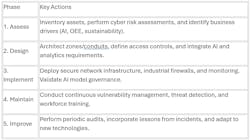Bridging IT and OT: Best practices for digital transformation in industrial environments
Key Highlights
- Establish shared governance and clear architectural principles, including network segmentation and DMZs, to effectively bridge IT and OT environments.
- Implement AI with a focus on data integrity, model governance, and secure edge deployment to maximize benefits while minimizing security risks.
- Invest in workforce training on cybersecurity, AI literacy, and cross-disciplinary collaboration to ensure human readiness aligns with technological advancements.
- Adopt a lifecycle approach to digital transformation, emphasizing continuous assessment, risk management, and iterative improvements to sustain resilience and competitiveness.
Industrial companies everywhere — from discrete manufacturing to the process industries — are accelerating their digital transformation. They see opportunities in real-time analytics, predictive maintenance and artificial intelligence (AI)-driven optimization. Yet for many organizations, the path to this smarter, more connected future runs directly through the shop floor and control rooms. That means operational technology (OT) must converge with information technology (IT) in ways that are secure, reliable and sustainable.
This article explores best practices to guide that journey. We will look at how manufacturers can integrate cybersecurity from the start, prepare their workforce for AI and other advanced technologies, and avoid common pitfalls when bridging IT and OT.
1. The stakes of OT digital transformation
OT networks control critical industrial processes — electric grids, chemical plants, pharmaceutical lines and more. Connecting these assets to enterprise IT or cloud systems multiplies the attack surface. A misconfigured switch or unauthorized changes on a PLC (programmable logic controller) can cause downtime, safety incidents or regulatory violations.
Meanwhile, business drivers such as sustainability goals, supply-chain pressures and competitive cost targets require more agile, data-driven operations. This dual pressure — more connectivity and more risk — makes a thoughtful approach to OT digital transformation essential.
2. Foundational principle: “Secure by design, not by patch”
A recurring lesson from incident investigations is that retrofitted security is far more expensive. Instead, industrial organizations should treat cybersecurity as an engineering discipline built into every phase of digital transformation. While it is clear that addressing cybersecurity in existing brownfield applications (legacy systems) is a necessary step — and one that presents many challenges — our emphasis here is on greenfield projects (new systems), where cybersecurity must be embedded from the very beginning. This is particularly critical as many AI and digitalization initiatives are still in their early phases.
More recently, there has also been growing recognition of the need for better collaboration between cybersecurity and safety controls. In this ecosystem — customers, system integrators and product manufacturers alike — aligning safety and cyber controls is becoming essential.
To achieve this in both brownfield and greenfield environments, the use of recognized standards as a blueprint is crucial. The ISA/IEC 62443 series of standards provides a lifecycle approach that aligns well with digital transformation initiatives:
- 62443-2-x: Defines security programs, roles and policies.
- 62443-3-x: Guides system design for IACS with security technologies, including security risk assessments, system security requirements and security levels, as well as principles such as network segmentation and defense-in-depth.
- 62443-4-x: Specifies secure product development and lifecycle requirements for suppliers.
By adopting these standards early, manufacturers avoid ad-hoc controls and ensure that new AI, analytics and cloud integrations inherit a hardened security posture.
While this article emphasizes Parts 2-x, 3-x, and 4-x — the sets most directly tied to system design and operation — the complete series is broader. Part 1-x covers foundational terminology, concepts and reference models. Part 5-x introduces the use of cybersecurity profiles (e.g., 62443-1-5 defines a scheme for 62443 security profiles) to help sectors apply requirements consistently. Part 6-x addresses evaluation methodologies.
Map to business risk
Compliance alone is not enough, and investments without strategy rarely succeed. Organizations must first identify which assets are most critical to their business and prioritize their protection. Risk assessment is the foundation of any cybersecurity strategy.
Leading organizations perform risk assessments that tie each control to a business outcome, such as minimizing production downtime or safeguarding intellectual property. This risk-based approach helps prioritize investments and fosters collaboration between engineering, operations and corporate cybersecurity teams.
3. Bridging IT and OT: Governance and architecture
IT and OT historically differ in culture and priorities. IT values confidentiality and rapid change; OT values availability and stability. Successful convergence requires a shared governance model and clear architectural principles.
Governance essentials
- Joint Change Control Boards that include both IT and OT decision-makers.
- Comprehensive OT asset inventory to track every device and software component. Visibility is the foundation for performing effective risk assessments
- ICS incident response playbooks that account for plant-floor realities, such as safe shutdown procedures, while considering safety, reliability and production (SRP) principles.
Architectural best practices
Each company should consider its own context and set realistic goals. The vast majority still lack many of the most important principles in their systems. Starting small and growing overtime is far better than unrealistic plans that never leave the paper. Below are some important must-haves.
- Zone and conduit model (ISA/IEC 62443-3-2): Segregate critical process control zones from enterprise networks with controlled conduits such as industrial firewalls and data diodes.
- IT/OT segmentation with a DMZ: A critical step toward a cybersecure topology is separating IT and OT networks and directing common data flows into a demilitarized zone (DMZ).
- Further OT segmentation: Once IT/OT separation is in place, divide the OT environment into smaller zones based on process dependencies and criticality. This enables more precise risk management and limits lateral movement during cyber incidents.
4. Harnessing AI safely in industrial settings
AI — often implemented as machine learning — offers transformative opportunities: predictive maintenance, energy optimization, visual inspection and more. But AI systems introduce new threat vectors and reliability concerns.
Key guidelines:
- Data integrity: Protect sensor data and historian archives from tampering. AI is only as good as its training data. Avoid direct sensor-to-cloud communications; instead, send data first to the DMZ, then to the cloud.
- Model governance: Maintain version control, ensure explainability and apply continuous validation to detect model drift.
- Secure edge deployment: When running AI inference at the edge, ensure secure boot, signed firmware and encryption aligned with ISA/IEC 62443-4-2.
By aligning AI initiatives with a structured cybersecurity framework, manufacturers can innovate without amplifying risk.
5. Preparing the industrial workforce
Technology is only half of the equation. Human readiness determines the success or failure of digital transformation.
Skills to prioritize
- Cybersecurity awareness for OT: From operators to maintenance teams, everyone should recognize anomalies and practice good cyber hygiene.
- Data literacy and AI basics: Equip technicians to interpret AI outputs and provide meaningful feedback for model improvement.
- Cross-discipline collaboration: Encourage “hybrid engineers” who can speak both IT and OT languages.
Cybersecurity training pathways
- ISA/IEC 62443 Cybersecurity Expert certifications help staff build structured knowledge.
- Scenario-based drills or tabletop exercises — for example, simulating a ransomware attack on a PLC — embed skills under realistic conditions.
A culture of continuous learning ensures that workforce capabilities evolve alongside technology.
6. Practical roadmap: From assessment to continuous improvement
Digital transformation and cybersecurity should unfold as a program, not a project. Below is a simplified roadmap with best practices.
This lifecycle approach ensures that each investment builds resilience rather than technical debt.
7. Common pitfalls and how to avoid them
Even well-resourced programs can stumble. Here are frequent challenges and practical mitigations:
- Lift and shift integrations: Simply connecting legacy OT networks to the cloud without segmentation or a clear understanding of the created connections invites cyber incidents.
Mitigation: Perform a risk assessment to understand specific vulnerabilities. - Underestimating human factors: Ignoring operator training often leads to insecure workarounds.
Mitigation: Build training into every deployment phase. - One-off pilots with no scaling plan or inadequate training data: Proof-of-concept AI projects may proceed without alignment to long-term architecture or sufficient data quality.
Mitigation: Ensure pilots align with enterprise architecture and establish robust data governance for model training.
Conclusion
OT digital transformation is no longer optional. To compete in a data-driven economy, manufacturers must bridge IT and OT data and knowledge without compromising safety or reliability. By embedding ISA/IEC 62443 principles, aligning AI with robust cybersecurity, and investing in workforce readiness, industrial leaders can transform with confidence.
This journey should not be seen as a one-time project, but as an ongoing program that strengthens both resilience and competitiveness. Companies that take deliberate steps today — conducting thorough risk assessments, segmenting IT and OT environments, establishing AI governance and training a cross-disciplinary workforce — will not only reduce the likelihood of cyber incidents but also position themselves to capture the full value of digital transformation. The organizations that succeed will be those that treat cybersecurity, effective AI governance and workforce readiness as strategic enablers of innovation, rather than mere compliance obligations.
About the Author

Felipe Costa
Senior Product Manager at Moxa Americas and Cybersecurity Director and Global Instructor of ISA/IEC 62443 for the International Society of Automation (ISA)
Felipe Sabino Costa is a Cybersecurity Director and a global, official instructor of ISA/IEC 62443, certified by ISA (International Society of Automation) and EC-Council, training professionals worldwide in the protection of industrial environments. He also serves as Senior Product Manager at Moxa Americas, leading networking and cybersecurity initiatives across the U.S., Canada, and Latin America. With over 20 years in the industrial sector and more than a decade dedicated to connectivity and cybersecurity, he combines strong technical expertise with a strategic business vision.

